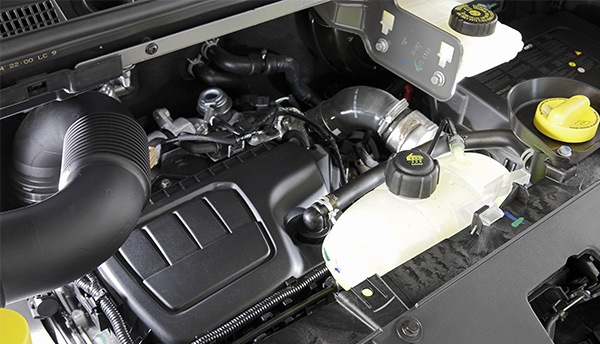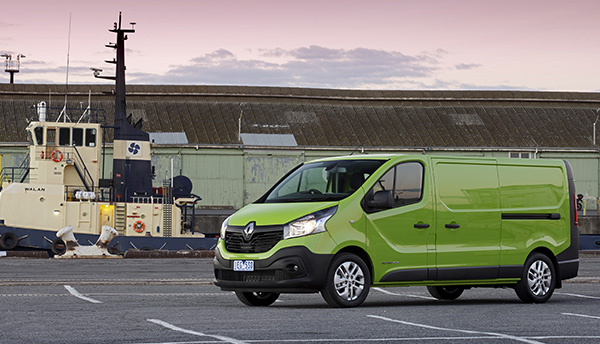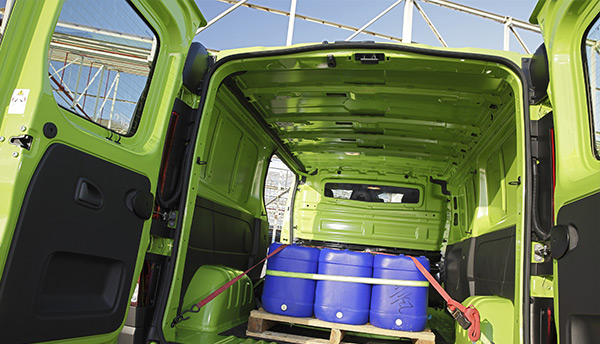The new incarnation of the Renault Trafic light commercial truck bills itself as an office and delivery van in one. We put the redesigned European favourite to the test in Adelaide.
My first impression of the new Renault Trafic — introduced to the Australian market in May — was based on how well it would serve as a CIA operations vehicle. Quite well, in my untrained assessment.
Granted, my first view was of an all-black Trafic, its rear doors open to reveal space for a one-man team to work not too uncomfortably alongside the requisite tracking equipment and shoe phones.
Granted, too, I probably watch too much television.
It turns out the Trafic also comes in non-spy colours, and has a wide range of non-spy, commercial functions in its repertoire. The badge has been leading the light commercial category across Europe for 17 years, with the newest version bigger and more comfortable than ever before.
Renault celebrates the robust and dynamic styling it has applied to the exteriors of both body types — all taut lines and structured forms, in line with the brand’s global styling identity.
For the non-design geeks among us, the Trafic looks reasonably pleasant from the front. From the side and back, it comes across as more box-like than a Hiace, for example, but that looks to be Renault quite sensibly prioritising usable space over curved edges.
Engine
The new Trafic offers three different engine and wheelbase combinations.
The entry point is the short-wheelbase L1H1 with a dCi 90 engine. The second of these keeps the same shorter body, L1H1, but features a twin turbo dCi 140 motor.
At this stage, the longer-wheelbase Trafic L2H1 is only available with the more powerful engine.
The smaller engine offers 66kW of power at 3,500rpm and 260Nm of torque at 1,500rpm. Its larger brother has 103kW of power at 3,500rpm and 340Nm of torque at 1,500rpm.
Transmission
All new Renault Trafic models ship with six-speed manual transmissions. No versions have an automatic gearbox on offer.
Cab and Controls
So let’s look instead at what this van can offer its business users. That was exactly the plan that the manufacturer had in the new model’s internal design, with every opportunity taken to further Renault’s claim of a veritable office-on-wheels.
The cabin has no fewer than 14 different stowage points for both specific and general items. Renault says busy delivery drivers should have safe and easy access to all the information, devices and coffee they need on the go.
Smartphone? The optional cradle is positioned on the dashboard with easy, safe access for the driver. The mount adapts to screen sizes of up to 4.7-inches (11.9cm), and is a short distance to the USB port for charging.
Tablet? The L1H1 has an optional retractable bracket, located just above the radio.
Laptop? The L2H1 has a centre-seat workstation that can either house a laptop out of sight or provide a steady surface that can be swivelled to face either driver or passenger.
Clipboard? Yep — they’ve got this covered too. The same L2H1 workstation can be manipulated (by tipping the centre seat-back forward) to clip in a board vertically, with the same ability to face either occupant.
In addition, both versions of the Trafic cabin have a range of trays and cubbies of different forms and sizes, ranging from a handy 0.2-litre tray for keys, pens and coins to a 54-litre space beneath the front passenger bench seat (on the twin turbo engine models) that can neatly stow away large and irregularly shaped items like specialist tools or work gear.
The dashboard is very like that of a passenger car. Like other Renault vehicles, it incorporates a “totem-style” centre console housing the multimedia and climate-control systems.
I failed to come prepared with my Herman’s Hermits CD but I’m told the chrome-plated surround speaker-system provides as much quality sound in the cabin as needed to drown out my singing.
Load
Behind the cabin, it’s all about the space. The gadgetry is kept to a minimum here, leaving the Trafic with up to 6.0 cubic-metres (in the L2H1) to do what it does best — load, carry and deliver cargo. Mo’ space; mo’ money — as the saying possibly goes.
It’s not just one big empty cube that those skilled in the packing arts have to work with. Unused space in the Trafic’s cabin allows extra room for particularly long cargo.
By opening a trap at the bottom of the bulkhead, users can securely stow items of up to 3.75 metres (L1H1) and 4.15 metres (L2H1) in length — the longest load-carrying capability in the market, Renault says.
Another opening mechanism for the front passenger seat-cushion frees up yet more space.
Inside, the L1H1’s cargo area is fitted with 16 tie-down rings, including six on the floor; the longer L1H2 has 18 rings, including eight on the floor. There are also two bulkhead hooks for hanging work clothes away from the cabin.
Both the new Trafics have the same rear-door aperture as previous models, meaning loyal customers can transfer interior fittings easily and without any adjustment or resizing required.
Optional extras include an overhead rack, with an independent carrying capacity of 13kg. And Renault offers an optional 12-volt power-supply unit on the right rear-door pillar — ideal for charging power-tools and the like.
Performance
For my test drive around Adelaide and the nearby hills, I was able to sample both long- and short-wheelbase versions. No choice of colours, unfortunately, and I was stuck with the “bamboo green” model pictured here.
That unique colour, new for Renault in 2015, made it an obvious stand-out on the city streets — enough to dispel any further thoughts of espionage.
Renault aimed to give its media test-drivers experience of the van in a range of road conditions, and tips its hat to the city of Adelaide for offering the best combination of city and close-by country driving, without the hang-ups of congestion.
Very sensible really — no one ever wrote a positive automotive review after spending an hour stuck on Melbourne’s West Gate Bridge or the M5.
There are few complaints on the open road. Cruise control, for example, is an easy-on, easy-off experience.
And with seat and steering wheel both easily adjustable, it’s simple to get into the most comfortable position for long-haul driving.
Verdict
The Trafic handles itself well in both environments. In the stop-start driving of the city, moving through the gears is smooth and responsive, although the quiet engine makes it easy to slip over the speed limit.
Still, the 300kg load strapped in the back barely registers when braking or taking off at the lights, and the steering handles cleanly throughout.
Specifications
Make/Model: Renault Trafic L1H1 (short wheel-base)
Engine: R9M 408
Power: 66kw @ 3,500rpm
Torque: 260Nm @ 1,500rpm
Transmission: Six-speed manual
Payload: 1,235kg
GVM: 2,900kg
Make/Model: Renault Trafic L2H1 (long wheel-base)
Engine: R9M 450 (R9M 408 also available)
Power: 103kW @ 3,500rpm
Torque: 340Nm @ 1,500rpm
Transmission: Six-speed manual
Payload: 1,274kg
GVM: 3,010kg

















